2023.08.03.110
Files > Volume 8 > Vol 8 No 3 2023
Taxonomic and ecological characteristics of algal assemblage in four geothermal springs of Odisha, India, including some new records
1Department of Botany, Bangabasi Evening College, University of Calcutta, 19 Rajkumar Chakraborty Sarani, Kolkata 700009, West Bengal, India
2Cryptogamic Unit, Central National Herbarium, Botanical Survey of India, Howrah-711103, West Bengal, India
3Department of Biology, Faculty of Science and Letters, Manisa Celal Bayar University, Manisa, Turkey
4Botany Department, Faculty of Science, Tanta University, Tanta, 31527, Egypt
*Corresponding author: [email protected]
Available from: http://dx.doi.org/10.21931/RB/2023.08.03.110
ABSTRACT
The present investigation conveys a unique diversity of cyanobacteria and eukaryotic algae from Atri, Taptapani, Tarabalo and Deulajhari geothermal springs of Odisha, India. The study revealed a floristic account of 48 taxa belonging to 39 cyanoprokaryotes, 5 diatoms, 2 charophytes and 1 each from desmids and euglenoids. One exciting record showed Jaaginema geminatum, as the most dominant cyanobacteria from euthermophilous and mesothermophilous communities. The cyanoprokaryotes, Romeria chlorina, Isocystis messanensis, Trichormus thermalis, Geitlerinema jasorvense and Westiellopsis indica were newly reported from the study area. Interestingly, Isocystis messanensis is newly added to the Indian flora. The physicochemical analysis of the spring water showed high sodium (97.72 mg/L) and calcium (5.5 mg/L) in Deulajhari, whereas high magnesium (0.8 mg/L) in Taptapani. While nitrate and phosphate were high in Deulajhari and Atri hot springs, Tarabalo has the highest sulfate content. While nitrate and phosphate content was high in Deulajhari and Atri hot springs, Tarabalo has the highest sulfate content. The Kruskal-Wallis test was applied to see the differences in the physicochemical parameters of the four geothermal springs, and significant differences were found at the bicarbonate value (HCO3-). Temperature variations in four thermal springs suggested the presence of euthermophilic and mesothermophilic species. The pH of the four water bodies was moderately basic. In addition, four geothermal springs were compared in terms of anions and cations using the Piper diagram, and it was determined that they showed Na+-K+-HCO3- properties. Principal Component Analysis (PCA) was performed under the CANOCO software to determine the statistical correlation between species and physicochemical parameters. As a result of the PCA, the total variation was 36.2500; the first axis explained 36.84% of the variance. The distribution pattern of all the species found in the four thermal springs has also been studied. A morphotaxonomic study was conducted with the help of microphotographs and line drawings.
Keywords: CANOCO, cyanobacteria, diversity, eukaryotic algae, Kruskal-Wallis, new record, physicochemical analysis, Piper diagram, taxonomy.
INTRODUCTION
Geothermal springs are formed with elevated temperature that rises from the earth's crust and the natural discharge of groundwater. There are about 400 big and small hot springs worldwide, including India.1 These naturally occurring thermal springs have temperatures of about 45-150°C, 4-10 times higher than the average water temperature.1 Based on their nature and composition, thermal springs have been categorized as iron springs, sulfur springs, salt springs, alkaline springs, radium springs, melanterite springs, mirabilite springs, aluminum springs etc.1 In India, geothermal springs are formed due to convectional heat circulation, deformation, metamorphism and magmatism at convergent plate margins, making them warm.1
The adverse conditions of the environment during the Archaeozoic and Proterozoic periods of the pre-Cambrian era resulted in the origin of cyanobacteria and a few eukaryotic algae. Present-day thermal springs show a similar milieu to the earlier environment, containing poor oxygen, high sulfur and temperature, and abundant reducing gasses like ammonia, methane and carbon-di-oxide.2 These conditions support the growth of unicellular and multicellular thermophiles, which include cyanobacteria and eukaryotic algae. Several researchers throughout the world have studied algal diversity in thermal springs.3-13 Physico-chemical analyses of thermal springs were also carried out in several studies to understand the geochemical activities.14-16
The Indian state Odisha comprises 4 thermal springs in the Khurda, Angul, Nayagarh and Ganjam districts. The hot springs associated with these districts are famous spiritual places. They are thronged by visitors for its sulfur-rich water, which possesses Ayurvedic and therapeutic healing power to cure many diseases. The main tank and outflow of the geothermal springs provide exceptional situations for studying the distributional pattern of many photosynthetic organisms, including cyanobacteria and eukaryotic algae. Continuous groundwater discharge and elevated temperatures make the surrounding habitat unique for sufficient growth of microorganisms. These microorganisms, including cyanobacteria and eukaryotic algae, can be a potential source of bioactive compounds like polysaccharides, essential vitamins, proteins and antibiotics.17 It has been reported that some extremophilic cyanobacteria are good sources of cancer drugs.18 Important photosynthetic iron proteins (Ferredoxin) siderophores were also identified from some thermophiles.17
The background of the study showed a unique diversity of algae in different thermal springs of Odisha and adjoining states. From South Odisha, Pattanaik and Rao19 have reported thermal cyanophytes, which Rao and Pattanaik have extended.20 Adhikary and Sahu have studied the physicochemical parameters of different geothermal springs of Odisha, showing cyanobacterial diversity.21 Bhakta et al. have reported 50 species of cyanobacteria and eukaryotic algae in four thermal springs of Odisha.12 Their study showed variation in species diversity in four thermal springs without any common species.
In other states of India, some diatoms from Ladakh thermal springs were previously studied.7 Thermal algae from Himalayan hot springs at the elevation of 6000 ft and 10 500 ft were reported by Prasad and Srivastava.4 Their study showed a diversity of 24 cyanobacteria, including one new variety, Oscillatoria jasorvensis var. thermalis. The extensive work done by Vasistha shows heterocystous and non-heterocystous cyanobacteria from different parts of India.5
Cyanobacterial flora from the Rajgir, Bihar, has also been reported.8 From Western India, Thomas and Gonzalves have reported 50 taxa altogether, of which 40 belong to diatoms and the remaining are cyanobacteria.9 Debnath et al. have investigated the mat-forming cyanobacteria species from the Bakreswar geothermal spring of West Bengal.2 Similarly, Mongra has reported both nitrogen-fixing and non-fixing cyanobacteria from the Tattapani thermal spring of Himachal Pradesh.22 Das has explored many cyanobacteria and eukaryotic algae from the hot springs of Arunachal Pradesh.13
Researchers from other parts of the world have also studied many thermal species.3,6,10 Physico-chemical analyses of thermal springs were also carried out in several studies to understand the geochemical activities.14-16
The present study shows the fluctuations in species composition due to anthropogenic and ecological activities. The species diversity in our study is found to be different from others due to the continuous exploitation of the study area by tourists. The aesthetic and spiritual nature makes the area more disturbed and creates an ecological imbalance to change the growth pattern of the microorganisms. The community structure and species composition are altered randomly. Hence, some new taxa may appear. Our study also reports a new Indian flora, which has not been found in earlier studies.
The main objectives of this investigation include the detailed morpho taxonomy of cyanobacteria and eukaryotic algae of four different hot springs of Odisha and maintaining the herbaria of preserved specimens with proper accession numbers at Central National Herbarium (CNH). The physicochemical properties of the water of different thermal springs were also analyzed concerning temperature gradient. Statistical analyses were carried out to examine the physicochemical properties of geothermal resources and their connections with the identified species. The Piper Diagram provided ease in classifying four geothermal springs of Odisha according to the anion and cation. The Kruskal-Wallis test was used to reveal the differences in some physicochemical parameters and several species in four geothermal springs of Odisha in SPSS 20.00 software (P<0.001). In addition, PCA analysis was performed under CANOCO 5.0 software to determine the statistical relationship between the species detected in this study and the physicochemical parameters of the geothermal springs. A comparative study was also done of the four thermal springs to show the diversity pattern.
MATERIALS AND METHODS
Study area
The state of Odisha comprises four thermal springs: Atri (20.20°N, 85.51°E), Taptapani (19.30°N, 84.24°E), Tarabalo (20.14°N, 85.10°E), Deulajhari (20.74°N, 84.49°E) (Figure 1).
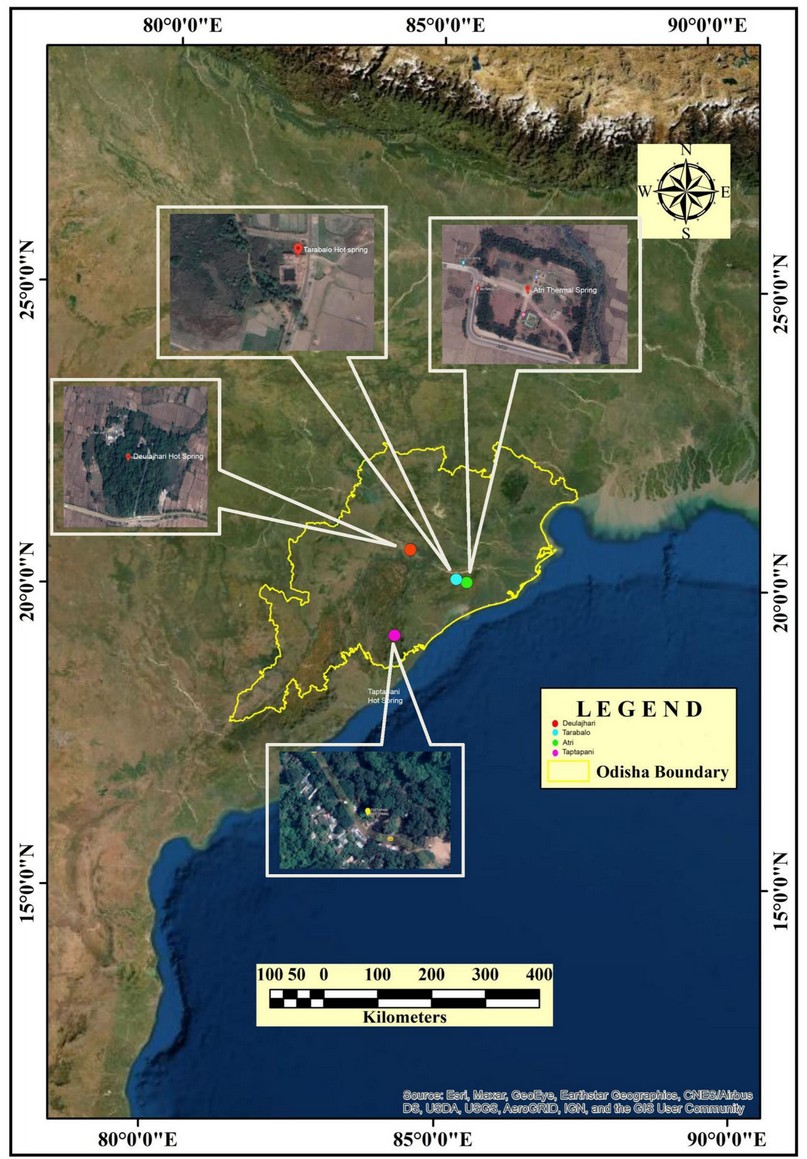
Figure 1. Geographical map showing four sampling sites.
Every hot spring has one core region and two or more outer channels. Bathing tanks are constructed mainly on these outer channels. Temperature Is highest in the core region and gradually decreases towards the outer channel. Habitat photographs of four sampling sites are given in Figure 2. This study used the Piper Diagram as a hydrogeochemical method to understand the characteristics of four geothermal water resources. Anions and cations are shown in two small-lower triangles, and all these ions are also shown in a large quadrilateral in the Piper diagram, a method frequently used to classify groundwater resources. Piper diagram facilitates the comparison and classification of natural spring waters.23 Piper diagram was made using GW Chart Software (USGS) and Microsoft Excel 2016.23-24 The Kruskal-Wallis test was used to reveal the differences in some physicochemical parameters in four geothermal springs of Odisha in SPSS 20.00 software (P<0.001). For the Kruskal-Wallis test, physicochemical parameters, which were determined to have essential effects on the distribution of the species by PCA analysis, were compared. Correlations between sampling stations, species, and physicochemical parameters of geothermal springs were statistically analyzed with CANOCO 5.0 software for Windows.25 To find the appropriate correlation analysis for this study, discriminant component analysis (DCA) was performed with the data. Looking at the DCA results, it was seen that the data were suitable for PCA analysis. The data were suitable for PCA analysis according to the gradient lengths value obtained from the DCA result. Also, Physicochemical parameters were analyzed with a Monte Carlo test (499 permutations).
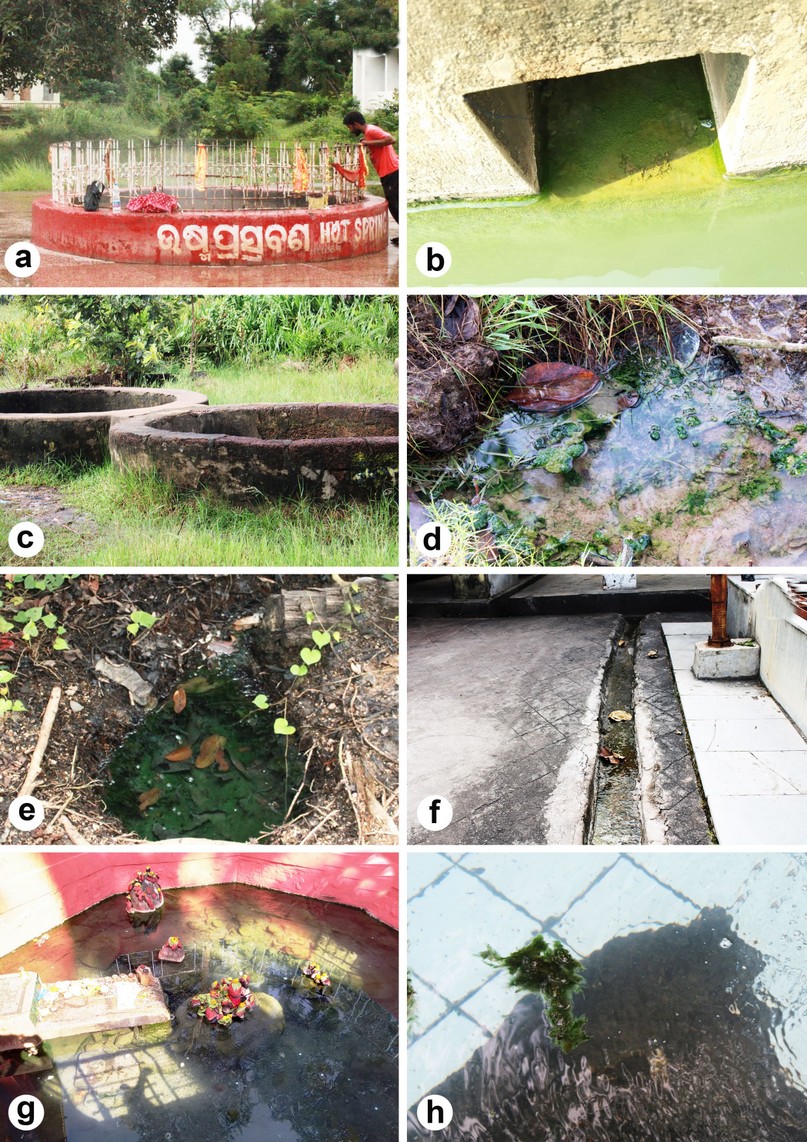
Figure 2. Habitat photographs of 4 thermal springs. a. Atri thermal spring main tank (60°C), b. Algal mats attached to cemented walls of the outer channel of Atri (40- 45°C), c. Tarabalo thermal spring outer channel tank (45-50°C), d. Tarabalo thermal spring main source (60°C), e. Deulajhari thermal spring main source (65°C), f. One of the outer channels of Deulajhari thermal spring (45°C), g. Taptapani thermal spring main tank (60°C), h. Algal mats floating on the bathing tank of Taptapani thermal spring (45°C).
Sampling and morpho-taxonomic investigation
Algal samples were collected from the main tank, i.e., the source and the bathing tanks, with the help of forceps in the case of floating mats and scalpels in the case of epilithic samples and stored in sterile collection vials. The collection vials were then allocated with voucher numbers and the collection date, preserved in 4% formaldehyde (v/v), and deposited at the cryptogamic unit, CNH, Botanical Survey of India (BSI), Howrah. Besides collection, the water temperature was recorded using a mercuric thermometer, and the water pH was recorded using a portable pH meter.
During collection, safety measures were taken by wearing heat-protective gloves to prevent burning. Thermal spring water was collected in a glass container and brought to the laboratory for further study. The microscopic study was conducted with Nikon Digital Camera DS-Ri1-U3 and operated by Nikon Imaging Software NIS-D+EDF. Line drawings were made under a compound microscope. Physico-chemical analysis of spring water was executed by following American Public Health Association (APHA) protocols.26
Algal taxa were identified with the help of standard literature and monographs.27-38 Botanical names of the species were updated using the classification system following AlgaeBase.39
RESULTS AND DISCUSSION
Taxonomic enumerations
Phylum: Cyanobacteria, Class: Cyanophyceae, Order: Chroococcales, Family: Aphanothecaceae; Genus: Aphanothece
1. Aphanothece bullosa (Meneghini) Rabenhorst Algas Phycochromaceas Complectens.
1-319. 1865 [Figures 3a and 8a]
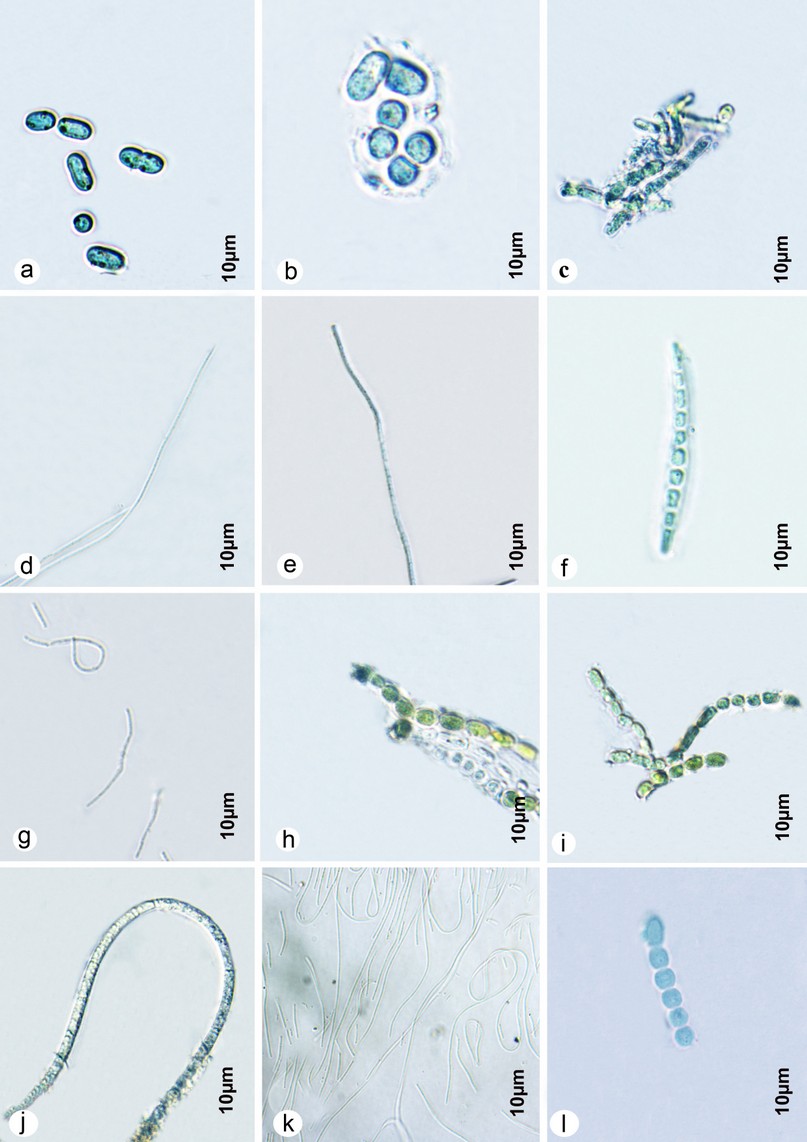
Figure 3. Microphotographs of a. Aphanothece bullosa, b. Aphanothece thermicola, c. Pseudanabaena mucicola, d. Jaaginema thermale, e. Jaaginema geminatum, f. Johannesbaptistia sp. g. Romeria chlorina, h-i. Westiellopsis indica, j. Geitlerinema jasorvense, k. Jaaginema angustissimum, l. Isocystis messanensis.
Homotypic Synonym and Basionym- Microcystis bullosa Meneghini 1837
Colonies mucilaginous, irregular with a firm surface; mucilage colorless with irregularly arranged cells; cells spherical to elongate cylindrical with rounded ends, cells with more or less homogeneous content, blue-green, 3.48-7.54 µm long and 3.48-4.06 µm broad.
Habitat: Dark blue-green mats attached to the walls of a bathing tank of Atri, 40°C-45°C Voucher number: 82016
Date of collection: 25.09.2019
2. A. thermicola Arch. Hydrobiol./Algolog. Stud. 21:359-376. 1978 [Figures 3b and 8b]
Colonies mucilaginous with irregularly scattered cells; cells oval to oval-cylindrical, 5.88-
6.46 µm long and 2.94-3.52 µm broad, distant from each other after cell division with dark blue-green content.
Habitat: Dark blue-green color mats attached to the cemented walls of bathing tanks of Atri, 40°C-45°C
Voucher number: 82016
Date of collection: 25.09.2019
Order: Synechococcales, Family: Pseudanabaenaceae, Genus: Pseudanabaena
3. Pseudanabaena mucicola (Naumann & Huber-Pestalozzi) Schwabe Gewässer und Abwässer. 36:7-39. 1964 [Figures 3c and 8c]
Homotypic Synonym and Basionym- Phormidium mucicola Nauman & Huber- Pestalozzi 1929; Heterotypic Synonym- Lyngbya naumannii Iltis 1972
Trichomes with diffluent, colourless mucilaginous envelope, aggregated together, short 4-6 celled, 3.6 µm long, 2.9 µm wide, blue-green, clearly constricted at cross- walls, rounded ends; cells cylindrical, 2-2.5 µm longer than wide, 5.88-8.82 µm long; cell content homogeneous or finely granulated without aerotopes; apical cell cylindrical, rounded without calyptra.
Habitat: Greenish-yellow mats attached to the cemented walls of the main tank of Atri, 60˚C.
Voucher number: 82016
Date of collection: 26.09.2019
4. P. oblonga Kullberg 1966 [Figures 4e and 9f]
Trichomes are short, curved, coiled, few-celled, blue-green cells longer than wide, 3-4µm long and 1.5 µm wide.
Habitat: Outer channel of Deulajhari hot spring, 40˚C Voucher number: 82086
Date of collection: 27.09.2019
5. P. catenata Lauterborn Verhandlungen des Naturhistorisch-Medizinischen Vereins zu Heidelberg ser. 13:395-481. 1915 [Figures 4f and 9g]
Trichomes solitary, aggregated along with other cyanobacteria, straight or rarely bent, highly constricted at the ends; cells blue-green, cylindrical, usually 1.5 longer than wide; cell content homogeneous without aerotopes; apical cell rounded or truncate.
Habitat: Yellow-green to yellow colored mats attached to the cemented walls of the outflow tanks of Atri, 60˚C
Voucher number: 82016
Date of collection: 25.09.2019
Order: Synechococcales; Family: Synechococcales familia incertae sedis; Genus: Jaaginema
6. Jaaginema thermale Anagnostidis Preslia, Praha. 73:359-375. 2001 [Figures 3d and 8d]
Thallus olive green to yellowish brown; trichomes solitary, rarely aggregated, slightly curved, pale blue-green, not attenuated at the end, 0.5-1.07 µm wide, not constricted at cross walls; cells isodiametric, cell content homogeneous.
Habitat: Floating mats in bathing tank of Atri thermal spring complex, 45°C Voucher number: 82018
Date of collection: 25.09.2019
7. J. geminatum (Schwabe ex Gomont) Anagnostidis & Komárek Archiv für Hydrobiologie, Supplement. 80:327-472. 1988 [Figures 3e and 8e]
Homotypic Synonym and Basionym- Oscillatoria geminata Schwabe ex Gomont 1892
Thallus in the form of thick mats, extended, yellowish green to olive green; trichomes variously curved, sometimes straight, yellowish green to light green color, immotile, slightly constricted at cross-wall, 1.8-2 µm wide; cells longer than wide, 2-2.5 µm long; apical cell rounded without calyptra.
Habitat: Thick mats attached on the stones of the main tank of Taptapani hotspring at 50°C, outer channel of Deulajhari hotspring at 60˚C and outer channel of Tarabalo hotspring at 45˚C
Voucher numbers: 82097, 82082, 82074
Date of collection: 28.09.2019, 27.09.2019, 26.09.2019
8. J. angustissimum (West & G. S. West) Anagnostidis & Komárek Archiv für Hydrobiologie, Supplement. 80:327-472. 1988 [Figures 3k and 9b]
Basionym- Oscillatoria angustissima West & G. S. West 1897
Trichomes thin without sheath, pale to dark green, 0.35-0.8 µm wide, variously curved, not constricted at cross-walls, not attenuated at the ends; cells isodiametric apical cells rounded.
Habitat: Yellow-green to light green color mats attached to the wall of one of the connecting tanks (45°C) of the Deulajhari thermal spring complex
Voucher number: 82086
Date of collection: 27.09.2019
Order: Chroococcales, Family: Cyanothrichaceae, Genus: Johannesbaptistia
9. Johannesbaptistia sp. G. De Toni Alcuni casi di omonimia (Missoficee). 7. 1934 [Figures 3f and 8f]
Colony pseudofilamentous, 3.92 µm wide and 39.28 µm long; cells isodiametric to slightly longer than wide, 1-2 µm long, 0.5-1.5 µm wide, solitary cells are devoid of their gelatinous envelopes, distant from each other; apical cells elongate conical; cell content pale blue-green, homogeneous and finely granulated.
Habitat: Attached on the wall of the bathing tank of Atri hot spring (45°C) along with other members of Chroococcaceae.
Voucher number: 82021
Date of collection: 25.09.2019
Order: Synechococcales, Family: Leptolyngbyaceae, Genus: Romeria
10. Romeria chlorina Böcher Kongelige Danske Videnskabernes Selskab Biologiske Meddelelser. 21:1-46. 1949 [Figures 3g and 6h]
Homotypic Synonym- Synechococcus chlorinus (Böcher) Komárek 1970
Trichomes disintegrated, 12-25 µm long, 1 µm wide, straight or curved, motile, not constricted at cross walls with rounded ends, olive green to pale blue; cells cylindrical, 1.2-2.5 µm long without aerotopes.
Habitat: Attached to the walls of the main kund of Atri hot spring (60°C) Voucher number: 82016
Date of collection: 25.09.2019
Order: Nostocales, Family: Hapalosiphonaceae, Genus: Westiellopsis
11. Westiellopsis indica Bourrelly Les Eugléniens, Peridiniens et Cryptomonadines. 1-512. 1970 [Figures 3h-i and 9a]
Thalli dirty blackish green; main filaments branched, monoseriate, constricted at cross walls; cells of main filaments mostly spherical, 4-6 µm wide and sometimes elongated 6.5-10 × 1.5-4 µm; cells of branches elongated, 7-10 µm long and 4.5-6 µm wide.
Habitat: Atri Main tank, 60°C Voucher number: 82016
Date of collection: 25.09.2019
Order: Oscillatoriales, Family: Coleofasciculaceae, Genus: Geitlerinema
12. Geitlerinema jasorvense (Vouk) Anagnostidis Plant Systematics and Evolution. 164:33-46, 1989 [Figures 3j and 8g]
Basionym- Oscillatoria jasorvensis Vouk 1919
Trichome yellowish-green to pale blue-green, slightly bent, thin, not attenuated at the ends; cells isodiametric or slightly longer than wide, 3.21-4.28 µm long,
3.57 µm broad, cell content homogeneous.
Habitat: Attached to the walls of main kund of Atri hot spring, 60°C Voucher number: 82016
Date of collection: 25.09.2019
Order: Nostocales, Family: Nostocaceae, Genus: Isocystis
13. Isocystis messanensis Borzì ex Bornet & Flahault Annales des Sciences Naturelles, Botanique, Septième Série. 7:177-262. 1886 [Figures 3l and 8i]
Filaments short, blue-green; trichomes narrowed towards both the ends, constricted at cross-walls; cells spherical, sometimes slightly elongated, 4.5-5 µm wide.
Habitat: Floating on the tanks of Deulajhari hot spring, 40˚C Voucher number: 82086
Date of collection: 27.09.2019
Order: Nostocales, Family: Aphanizomenonaceae, Genus: Dolichospermum
14. Dolichospermum smithii (Komárek) Wacklin, L. Hoffmann & Komárek Fottea. 9(1):59-64. 2009 [Figures 4a and 9c]
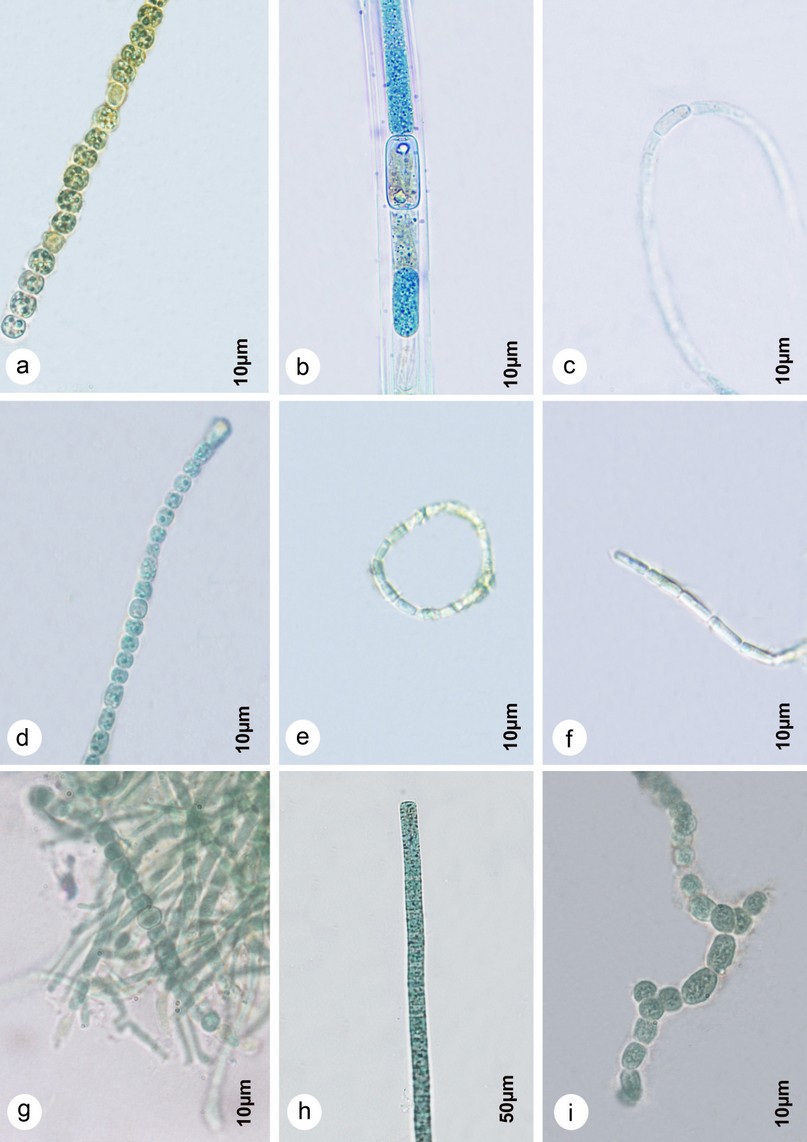
Figure 4. Microphotographs of a. Dolichospermum smithii, b. Aulosira implexa, c. Aphanizomenon flexuosum, d. Anabaena oscillarioides, e. Pseudanabaena oblonga, f. Pseudanabaena catenata, g. Nodularia sphaerocarpa, h. Oscillatoria nitida, i. Mastigocladus laminosus.
Homotypic synonyms: Anabaena solitaria f. smithii Komárek 1958, Anabaena smithii (Komárek) M. Watanabe 1992; Basionym: Anabaena solitaria f. smithii Komárek 1958
Planktonic, trichomes solitary, straight or irregularly curved, constricted at cross- walls with rounded ends; cells barrel-shaped, blue-green with aerotopes, 5-6 × 6.4-11µm, end cell spherical, rounded; heterocysts solitary, intercalary, spherical or slightly elongate, 5.5 × 3.5-
4.5 µm.
Habitat: Floating on the tanks of Deulajhari hot spring at 40˚C
Voucher number: 82089
Date of collection: 27.09.2019
Order: Nostocales, Family: Nostocaceae, Genus: Aulosira
15. Aulosira implexa Bornet & Flahault Annales des Sciences Naturelles, Botanique, Septième Série. 7:177-262. 1886 [Figures 4b and 9d]
Homotypic Synonym- Nodularia implexa (Bornet & Flahault) Bourrelly 1970
Filaments in clusters, rarely solitary; sheaths thick, colourless; trichomes cylindrical 8-
9.5 µm broad, slightly constricted at cross walls; cells longer than wide; heterocysts solitary, cylindrical with rounded or blunt ends, 15-21 µm wide, 10 µm long.
Habitat: Floating on the outer channel of Tarabalo hot spring, 45°C Voucher number: 82077
Date of collection: 26.09.2019
Order: Nostocales, Family: Aphanizomenonaceae, Genus: Aphanizomenon
16. Aphanizomenon flexuosum Komárek & Kovácik Plant Systematics and Evolution. 164:47-64. 1989 [Figures 4c and 9g]
Trichomes either single or aggregated together, straight or curved, very slightly constricted at cross-walls with narrowed and hyaline end cells; cells isodiametric or longer than wide, 4.5-5.5 µm long and 3-4 µm wide, pale blue green with small numerous aerotopes; heterocysts intercalary, solitary, cylindrical 8.5-10 µm long and 2.5 µm wide.
Habitat: Attached on the cemented all of one of the tanks of Deulajhari thermal springs, 60˚C
Voucher number: 82082
Date of collection: 27.09.2019
Order: Nostocales, Family: Nostocaceae, Genus: Anabaena
17. Anabaena oscillarioides Bory ex Bornet & Flahault Annales des Sciences Naturelles, Botanique, Septième Série. 7:177-262. 1886 [Figures 4d and 9e]
Heterotypic Synonym- Anabaena pseudoscillatoria Bory 1822
Trichmes single or in groups, distinctly constricted at cross walls, not attenuated towards ends; cells barrel shaped, isodiametric or slightly longer than wide, pale blue-green, end cell slightly conical; heterocysts solitary, intercalary, barrel shaped, longer than wide, 2.9-4.7 µm.
Habitat: Blue-green floating mats on the tank of Tarabalo thermal spring complex, 40˚C Voucher number: 82024
Date of collection: 26.09.2019
Order: Nostocales, Family: Aphanizomenonaceae, Genus: Nodularia
18. Nodularia sphaerocarpa Bornet & Flahault Annales des Sciences Naturelles, Botanique, Septième Série. 7:177-262. 1888 [Figures 4g and 9i]
Homotypic Synonym- Nodularia harveyana var. sphaerocarpa (Bornet & Flahault) Elenkin 1916
Filaments in mats with other cyanobacteria; trichomes cylindrical, straight or slightly waved, constricted at cross-walls; sheath colourless, firm and thin; cells wider than long, 2.5-3.5 × 3.52-4.70 µm, without gas vesicles, blue-green; end cells rounded; heterocysts solitary, intercalary, spherical, 4.5-5.5 × 5.5-6.5 µm.
Habitat: Attached on the walls of one of the tanks of Deulajhari, 60˚C Voucher number: 82082
Date of collection: 27.09.2019
Order: Oscillatoriales, Family: Oscillatoriaceae, Genus: Oscillatoria
19. Oscillatoria nitida Schkorbatov [Škorbatov] 1923 [Figures 4h and 9j]
Trichomes solitary, straight or slightly curved at cross-walls, blue-green with blunt or flat ends; sheaths thin and fine; cells always shorter than wide, 3-4.54 µm wide and 1.2 µm long. Habitat: Outlet or outer channel of Deulajhari thermal spring, 40˚C
Voucher number: 82089
Date of collection: 27.09.2019
20. O. princeps Vaucher ex Gomont Annales des Sciences Naturelles, Botanique, Série. 7(16):91-264.
1892 [Figures 5a and 10d]
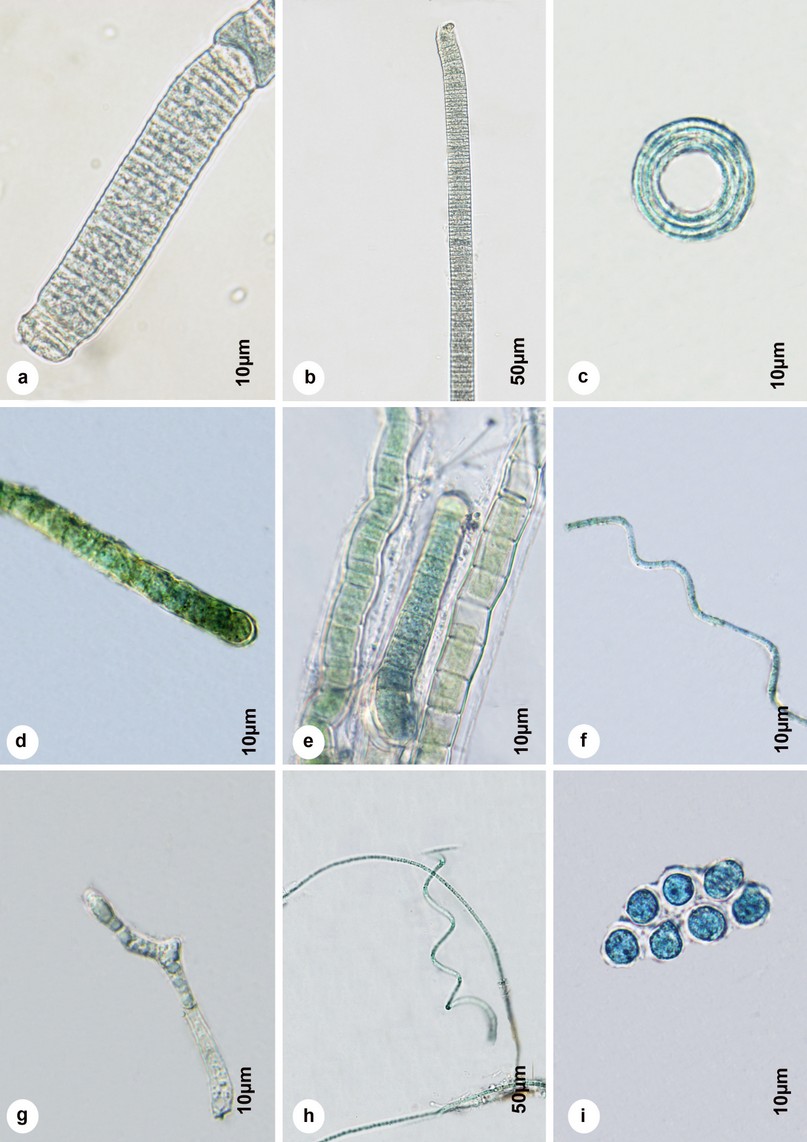
Figure 5. Microphotographs of a. Oscillatoria princeps, b. Oscillatoria curviceps, c. Planktolyngbya circumcreta, d. Microchaete tenera, e. Microchaete calothrichoides, f. Leptolyngbya thermobia, g. .Arthronema africanum, h. Arthrospira jenneri, i. Chroococcus membraninus.
Homotypic Synonyms- Trichophorus princeps (Vaucher) Desvaux 1809, Oscillatoriella princeps (Vaucher) Gaillon 1833, Lyngbya princeps (Vaucher ex Gomont) Hansgirg 1893
Thallus blackish blue-green, attached or free floating; trichomes blue-green, 16-20 µm wide, straight or sometimes slightly curved, not constricted at cross-walls and with necridic cells, bent and nearly truncate ends; cells brick like, shorter than wide, 3.75-4.37 µm long, cell content granular; apical cell rounded and truncate without calyptra.
Habitat: Floating on bathing tank of Taptapani hot spring, 45˚C Voucher number: 82096
Date of collection: 28.09.2019
21. O. curviceps C. Agardh ex Gomont Annales des Sciences Naturelles, Botanique, Série. 7(16):91-264. 1892 [Figures 5b and 10e]
Trichomes solitary, cylindrical, straight, not constricted at cross-walls, blue-green, slightly attenuated at the end; cells 3.12-4.68 µm long, 15.62 µm wide; apical cells rounded and flattened.
Habitat: Floating on bathing tank of Taptapani hot spring, 45˚C Voucher number: 82096
Date of collection: 28.09.2019
22. O. sancta Kützing ex Gomont Annales des Sciences Naturelles, Botanique, Série. 7(16):91-264.
1892 [Figures 7a and 11e]
Homotypic Synonym- Lyngbya sancta (Gomont ex Gomont) Hansgirg 1893 Heterotypic Synonym- Oscillaria sancta Kützing 1847
Trichomes olive green or blue-green, 22.72 µm wide, constricted at cross-walls, straight or slightly narrower in apical part, sometimes with thin sheath; cells discoid, 2.5-3.8 µm long; apical cells hemispherical with thickened calyptroid outer cell wall.
Habitat: Outer channel of Tarabalo hotspring, 37˚C Voucher number: 82089
Date of collection: 26.09.2019
Order: Nostocales, Family: Hapalosiphonaceae, Genus: Mastigocladus
23. Mastigocladus laminosus Cohn ex Kirchner Die natürlichen Pflanzenfamilien nebst ihren Gattungen und wichtigeren Artn insbesondere den Nutzpflanzen unter Mitwirkung zahlreicher hervorragender Fachgelehrten I. 45-92. 1898 [Figures 4i and 10a]
Heterotypic Synonyms- Fischerella laminosa (Hansgirg ex Bornet & Flahault) Castenholz, Hapalosiphon luminous Hansgirg ex Bornet & Flahault 1886
Thallus dark-green, leathery, firm; filaments densely aggregated, 4.5-5 µm wide with thin, firm gelatinous sheaths, true branched (T or Y shaped branching); branches become narrower gradually away from the main filament, 3.2 µm wide; trichomes constricted at cross-walls; cells of main filament barrel shaped irregular or longer than wide, 5.5-9 µm long, cells of branches longer than wide; apical cells elongated and rounded.
Habitat: Attached on the rocks of main kund of Deulajhari in form of mats, 65˚C Voucher number: 82081
Date of collection: 27.09.2019
Order: Synechococcales, Family: Leptolyngbyaceae, Genus: Planktolyngbya
24. Planktolyngbya circumcreta (G. S. West) Anagnostidis & Komárek Archiv für Hydrobiologie, Supplement. 80:327-472. 1988 [Figures 5c and 10j]
Basionym- Lyngbya circumcreta G. S. West 1907
Filaments solitary, spirally coiled, coils 28.12 µm broad, circular in outline with 5.5 turns; sheaths thin, colourless; trichomes olive green to pale blue-green, 1.87 µm wide, not constricted at cross walls; cells isodiametric or shorter than wide; 0.8-1.25 µm long; apical cell not attenuated.
Habitat: Attached on the rocks of main kund of Taptapani hot spring, 50˚C Voucher number: 82094
Date of collection: 28.09.2019
Order: Nostocales, Family: Rivulariaceae, Genus: Microchaete
25. Microchaete tenera Thuret ex Bornet & Flahault Annales des Sciences Naturelles, Botanique, Septième série. 5:51-129. 1886 [Figures 5d and 10c]
Homotypic Synonym- Fremyella tenera (Thuret ex Bornet & Flahault) G. De Toni 1936
Filaments solitary, dirty blue green, 7.9-8.23 µm wide, sheaths thin, firm, colourless; trichomes cylindrical, constricted at cross-walls; cells isodiametric or shorter than wide, 5.5-5.8 × 8.5 µm, blue green, apical cells elongated and rounded; heterocysts basal, oval, 8.8 × 7.5 µm.
Habitat: Floating on the bathing tank of Taptapani, 45˚C
Voucher number: 82091
Date of collection: 28.09.2019
26. M. calothrichoides Hansgirg Beihefte zum Botanischen Centralblatt. 18(Abt. 2):417-522.
1905 [Figures 5e and 10f]
Filaments solitary, slightly bent or curved towards the end; sheaths thin, continuous and firm; trichome consists of few cells, constricted at cross-walls, dirty blue-green; cells shorter than long, 5.9 µm long and 8.98-9 µm wide, terminal cell rounded, somewhat narrower or conical; heterocysts basal, ellipsoidal 8.9 µm wide and 5.3-5.5 µm long.
Habitat: Floating on the bathing tank of Taptapani hot spring, 45˚C Voucher number: 82091
Date of collection: 28.09.2019
Order: Synechococcales, Family: Leptolyngbyaceae, Genus: Leptolyngbya
27. Leptolyngbya thermobia Anagnostidis Preslia, Praha. 73:359-375. 2001
[Figures 5f and 10b]
Filaments wavy or spirally coiled, distance between two spirals 15.62 µm, spirals 9.37µm wide; sheaths thin and colourless and attached to trichomes; trichomes not constricted at cross-walls, blue-green 3.5-4 µm wide, flat ends; cells isodiametric or longer than wide, 4.5-5 µm long; cell content homogeneous with a single granule witheither side of the cross wall.
Habitat: Main kund of Taptapani thermal spring, 50˚C Voucher number: 82094
Date of collection: 28.09.2019
Order: Synechococcales, Family: Leptolyngbyaceae, Genus: Arthronema
28. Arthronema africanum (Schwabe & Simonsen) Komárek &
Lukavsky Algological Studies. 50-53:249-267. 1988 [Figures 5g and 10g]
Basionym: Pseudanabaena africana Schwabe & Simonsen 1961
Trichomes simple, devoid of sheaths with irregular and swollen involution cells; cells 2.5-3.5 µm in diameter, blue-green.
Habitat: Main Kund of Taptapani thermal spring, 50˚C Voucher number: 82094
Date of collection: 28.9.2019
Order: Oscillatoriales, Family: Microcoleaceae, Genus: Arthrospira
29. Arthrospira jenneri Stizenberger ex Gomont Annales des Sciences Naturelles, Botanique Série. 7(16):91-264. 1892 [Figures 5h and 10h]
Homotypic Synonyms- Spirulina jenneri (Stizenberger ex Gomont) Geitler 1925, Oscillatoria jenneri (Stizenberger ex Gomont) Compère 1974
Trichomes without sheaths, dark blue-green, loosely screw-like coiled 1.5-3.3 µm wide, not constricted at cross walls; spirals 9.09 µm wide, not tapered towards the ends, distance between spirals 27.5 µm; cells isodiametric, 1.5 µm long, without aerotopes; apical cells rounded without any other thickening.
Habitat: Floating on the bathing tank of Taptapani, 45˚C
Voucher number: 82093
Date of collection: 28.09.2019
Order: Chroococcales, Family: Chroococcaceae, Genus: Chroococcus
30. Chroococcus membraninus (Meneghini) Nägeli Neue Denkschriften der Allg.
Schweizerischen Gesellschaft für die Gesammten Naturwissenschaften. 10(7):i-viii, 1-139. 1849 [Figures 5i and 10i]
Basionym- Pleurococcus membraninus Meneghini 1842
Homotypic Synonyms- Pleurococcus membraninus Meneghini 1842, Gloeocapsa membranina (Meneghini) F. E. Drouet & W. A. Daily 1948
Common mucilage not lamellated with irregularly arranged cells; cells spherical 8-10 µm in diameter, dark blue-green with finely granular content.
Habitat: Attached to stony surface of the main tank of Taptapani hot spring, 50˚C
Voucher number: 82093
Date of collection: 28.09.2019
Order: Nostocales, Family: Scytonemataceae, Genus: Scytonema
31. Scytonema stuposum Bornet ex Bornet & Flahault Annales des Sciences Naturelles, Botanique, Septième série. 5:51-129. 1886 [Figures 6a and 11a]
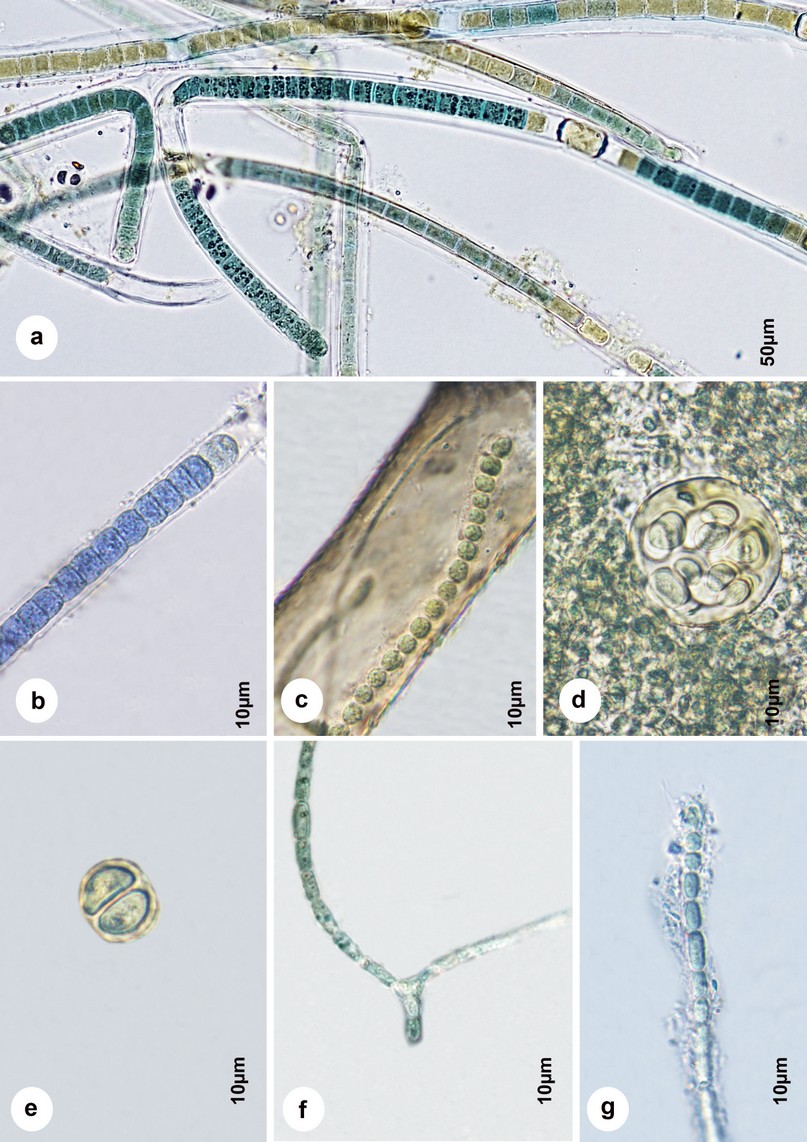
Figure 6. Microphotographs of a. Scytonema stuposum, b. Tolypothrix penicillata, c. Anabaena laxa, d. Aphanocapsa parietina, e. Gloeocapsa arenaria, f. Fischerella thermalis, g. Trichormus thermalis.
Thallus, wooly, prostrate, dark, dirty blue-green; filaments entangled, 15-18 µm wide, pseudo-branched, sheath thick, transparent, firm; trichomes cylindrical, constricted at cross-walls, slightly narrowed towards the end, dark blue green; cells barrel shaped, 1.5-2 µm, 1.5-1.92 µm long; heterocysts solitary, cylindrical, olive green or yellow in colour, 16 µm long and 1.92 µm wide.
Habitat: Floating on the bathing tank of Taptapani, 45˚C
Voucher number: 8209
Date of collection: 28.09.2019
Order: Nostocales, Family: Tolypothrichaceae, Genus: Tolypothrix
32. Tolypothrix penicillata Thuret ex Bornet & Flahault Annales des Sciences Naturelles, Botanique, Septième série. 5:51-129. 1886 [Figures 6b and 11c]
Heterotypic Synonyms- Scytonema penicillatum C. Agardh 1817, Tolypothrix distorta var.
penicillata (C. Agardh) Lemmermann 1907
Filaments pseudo-branched, 11.5-15 µm wide, blue green; sheaths thin or thick, colourless; trichomes cylindrical, constricted at cross walls, attenuated towards the end; cells isodiametric in middle part 8.75 µm wide and longer than wide towards the end; heterocysts basal, cylindrical or spherical, solitary, 6.25 µm wide.
Habitat: Floating on the outer channel of Tarabalo hot spring, 45˚C Voucher number: 82078
Date of collection: 26.09.2019
Order: Nostocales, Family: Nostocaceae, Genus: Anabaena
33. Anabaena laxa A. Braun Annales des Sciences Naturelles, Botanique, Septième Série. 7: 177-262. 1886 [Figures 6c and 11b]
Trichomes straight or slightly curved, solitary, mucilaginous envelop inconspicuous, cylindrical, cross walls constricted, not attenuated towards ends; cells spherical, barrel shaped, isodiametric or shorter than wide, 4.70-3.52 µm wide and 2.9 µm long; heterocysts solitary, intercalary, spherical, 2.94-4.1µm × 4.70-3.52 µm.
Habitat: Floating mats on tanks of Tarabalo thermal spring complex, 40˚C
Voucher number: 82023
Date of collection: 25.09.2019
Order: Synechococcales, Family: Merismopediaceae, Genus: Aphanocapsa
34. Aphanocapsa parietina (Nägeli ex Kützing) Nägeli Neue Denkschriften der Allg. Schweizerischen Gesellschaft für die Gesammten
Naturwissenschaften. 10(7):i-viii, 1-139. 1849 [Figures 6d and 11h]
Basionym- Palmella parietina Nägeli ex Kützing 1849
Cells with individual gelatinous envelopes, spherical, usually blue-green, yellowish or brownish, 6.5 µm in diameter.
Habitat: Outer channel of Tarabalo hot spring, 55˚C Voucher number: 82077
Date of collection: 26.09.2019
Order: Chroococcales, Family: Microcystaceae, Genus: Gloeocapsa
35. Gloeocapsa arenaria (Hassall) Rabenhorst Algas phycochromaceas complectens, Lipsiae [Leipzig]: Apud Eduardum Kummerum. 1-319. 1865 [Figures 6e and 11g]
Basionym- Haematococcus arenarius Hassall 1845
Cells enclosed by wide mucilaginous envelopes, 4.5-6 µm wide; cells spherical, yellowish or blue-green, 5.5-6.5 µm in diameter.
Habitat: Outer channel of Tarabalo hot spring (55˚C) and outer channel of Taptapani hot spring (45˚C)
Voucher number: 82077, 82095
Date of collection: 26.09.2019, 28.9.2019
Order: Nostocales, Family: Hapalosiphonaceae, Genus: Fischerella
36. Fischerella thermalis Gomont Journal de Botanique. 9:49-52. 1895 [Figures 6f and 11j]
Heterotypic Synonyms- Fischera thermalis Schwabe 1837; Hapalosiphon thermalis (Schwabe) Borzì 1917
Thallus prostrates, dark blue-green; main filament creeping, entangled and branched laterally; branches erect and solitary, cylindrical, 4-5.5 µm wide; sheaths thin; trichomes constricted at cross walls; cells blue-green, 5.5 µm wide and 2.9 µm long; heterocysts intercalary and cylindrical.
Habitat: Main kund of Tarabalo hot spring, 60˚C Voucher number: 82073
Date of collection: 26.09.2019
Order: Nostocales, Family: Nostocaceae, Genus: Trichormus
37. Trichormus thermalis (V. Vouk) Komárek & Anagnostidis Algological Studies. 56:247-
345. 1989 [Fig. 6g, Fig. 11d]
Basionym- Anabaena thermalis V. Vouk 1916; Homotypic Synonym- Anabaena thermalis V. Vouk 1916
Trichomes straight, without sheath, constricted at cross-walls; cells isodiametric or slightly longer than broad, 2.5-4.5 µm × 2-3.5 µm, apical cell conical and rounded.
Habitat: Main kund of Tarabalo hot spring, 60˚C Voucher number: 82073
Date of collection: 26.09.2019
Order: Oscillatoriales, Family: Microcoleaceae, Genus: Planktothrix
38. Planktothrix isothrix (Skuja) Komárek & Komárková Czech Phycology. 4:1-
18. 2004 [Figures 7b and 11f]

Figure 7. Microphotographs of a. Oscillatoria sancta, b. Planktothrix isothrix, c. Spirulina meneghiniana, d. Navicula amphirhynchus, e. Brachysira exilis, f. Cocconeis placentula, g. Gyrosigma acuminatum, h. Rhopalodia operculata, i. Spirogyra reticulata, j. Spirogyra condensata, k. Heimansia pusilla, l. Trachelomonas volvocinopsis.
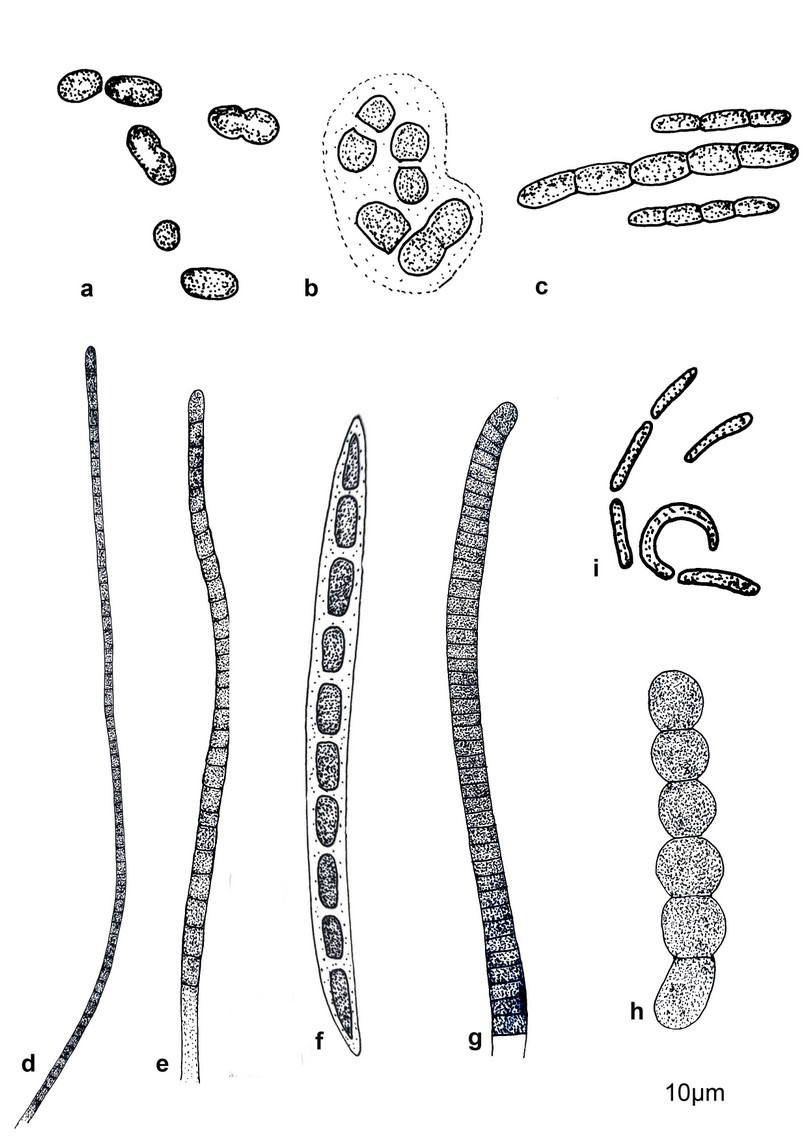
Figure 8. Line drawings of a. Aphanothece bullosa, b. Aphanothece thermicola, c. Pseudanabaena mucicola, d. Jaaginema thermale, e. Jaaginema geminatum, f. Johannesbaptistia sp., g. Geitlerinema jasorvense, h. Romeria chlorina, i. Isocystis messanensis.

Figure 9. Line drawings of a. Westiellopsis indica, b. Jaaginema angustissimum, c. Dolichospermum smithii, d. Aulosira implexa, e. Anabaena oscillarioides, f. Pseudanabaena oblonga, g. Aphanizomenon flexuosum, h. Pseudanabaena catenata, i. Nodularia sphaerocarpa, j. Oscillatoria nitida.
Basionym- Oscillatoria agardhii var. Isothrix Skuja 1948; Homotypic Synonym- Oscillatoria agardhii var. isothrix Skuja 1948
Trichomes pale blue-green, solitary, rarely in clusters, straight or slightly curved at the apical portion, not constricted at cross-wall; cell isodiametric or shorter than wide, 5.45-7.5 × 10 µm, with numerous aerotopes; apical cells slightly conical, rounded without calyptra or any outer cell wall thickening.
Habitat: Taptapani Bathing tank, 45˚C
Voucher number: 82097
Date of collection: 28.09.2019
Order: Spirulinales, Family: Spirulinaceae, Genus: Spirulina
39. Spirulina meneghiniana Zanardini ex Gomont Annales des Sciences Naturelles, Botanique, Série. 7(16):91-264. 1892 [Figures 7c and 11i]
[Geitler, 1932; Komárek & Anagnostidis, 2005; McGregor, 2007; Whitton, 2011] Trichomes dirty blue-green, 1.5-2 µm wide, regularly more or less loosely screw-like, coiled, not constricted at cross-walls; distance between two coils is 3.5-4.68 µm; cells blue-green, apical cell rounded.
Habitat: Floating on bathing tank of Taptapani hot spring, 45˚C Voucher number: 82095
Date of collection: 28.09.2019
Phylum: Bacillariophyta, Class: Bacillariophyceae, Order: Naviculales, Family: Naviculaceae, Genus: Navicula
40. Navicula amphirhynchus Ehrenberg Abhandlungen der Königlichen Akademie der Wissenschaften zu Berlin. 1841:291-445. 1843 [Figures 7d and 12a]
Frustules lanceolate, raphae thin, central area widened; frustules 42.30 µm long and 9-11.5 µm wide, striae not clearly visible.
Habitat: Outer channel of Deulajhari thermal spring, 40˚C
Voucher number: 82086
Date of collection: 27.09.2019
Order: Naviculales, Family: Brachysiraceae, Genus: Brachysira
41. Brachysira exilis (Kützing) Round & D. G. Mann Archiv für Protistenkunde. 124(3):221-231. 1981 [Figures 7e and 12b]
Basionym and Homotypic Synonym- Navicula exilis Kützing 1844
Frustule rectangular, valve end flat and of similar size, striae marginal, present closely to each other, 90.9 µm long and 14.54 µm broad.
Habitat: Outer channel of Deulajhari hot spring, 40˚C Voucher number: 82086
Date of collection: 27.09.2019
Order: Cocconeidales, Family: Cocconeidaceae, Genus: Cocconeis
42. Cocconeis placentula Ehrenberg Leipzig: Verlag von Leopold Voss. 194. 1838 [Figures 7f and 12c]
Homotypic Synonyms- Cocconeis pediculus var. placenta (Ehrenberg) Grunow 1867; Cocconeis communis var. placenta (Ehrenberg) O. Kirchner 1878; Cocconeis communis f. placenta (Ehrenberg) Chmielevski 1885
Valves are elliptical, distinct pseudo raphae, striae narrow, linear, radially arranged, 29 µm long and 15.45 µm broad.
Habitat: Outer channel of Deulajhari thermal spring, 40˚C Voucher number: 82086
Date of collection: 27.09.2019
Order: Naviculales, Family: Naviculaceae, Genus: Gyrosigma
43. Gyrosigma acuminatum (Kützing) Rabenhorst Leipzig: Eduard Kummer. 1-
72. 1853 [Figures 7g and 12d]
Basionym- Frustulia acuminata Kützing 1833
Valve sigmoid, consisting of convex and concave segments, broadly lanceolate, gradually narrowing towards both ends, 136.36 µm long, 11.81 µm wide.
Habitat: Outer channel of Tarabalo thermal spring, 37˚C Voucher number: 82089
Date of collection: 26.09.2019
Order: Rhopalodiales, Family: Rhopalodiaceae, Genus: Rhopalodia
44. Rhopalodia operculata (C.Agardh) Håkanasson Beihefte zur Nova Hedwigia. 64:163-168. 1979 [Figures 7h and 12e]
Basionym- Frustulia operculata C. Agardh 1827
Valves single, dorsal margin convex, notched in central portion, ventral margin straight, lanceolate to elliptic in girdle view, 50 µm long and 22 µm wide; costae distinct; striae transverse, apart from each other.
Habitat: Outer channel of Deulajhari hot spring, 40˚C Voucher number: 82086
Date of collection: 27.09.2019
Phylum: Charophyta, Class: Zygnematophyceae, Order: Zygnematales, Family: Zygnemataceae, Genus: Spirogyra
45. Spirogyra reticulata Nordstedt Botaniska Notiser. (4):113-122. 1880 [Figures 7i and 12f]
Heterotypic Synonym- Spirogyra reticulata var. cylindrospora Liu 1980
Vegetative cells 75-90 µm broad, 135-140 µm long; transverse wall plane; chloroplasts 3 per cell.
Habitat: Outer channel of Tarabalo thermal spring, 35˚C Voucher number: 82022
Date of collection: 26.09.2019
46. S. condensata (Vaucher) Dumortier Tournay: Imprimerie de Ch. Casterman-Dieu, Rue de pont No. 10. 1-116. 1822 [Figures 7j and 12g]
Homotypic Synonym- Conjugata condensata Vaucher 1803; Basionym- Conjugata condensata
Voucher
Vegetative cells 60-70 µm broad, 120-150 µm long; transverse walls plane; chloroplast single per cell.
Habitat: Outer channel of Tarabalo thermal spring, 35˚C
Voucher number: 82022
Date of collection: 26.09.2019
Order: Desmidiales, Family: Desmidiaceae, Genus: Heimansia
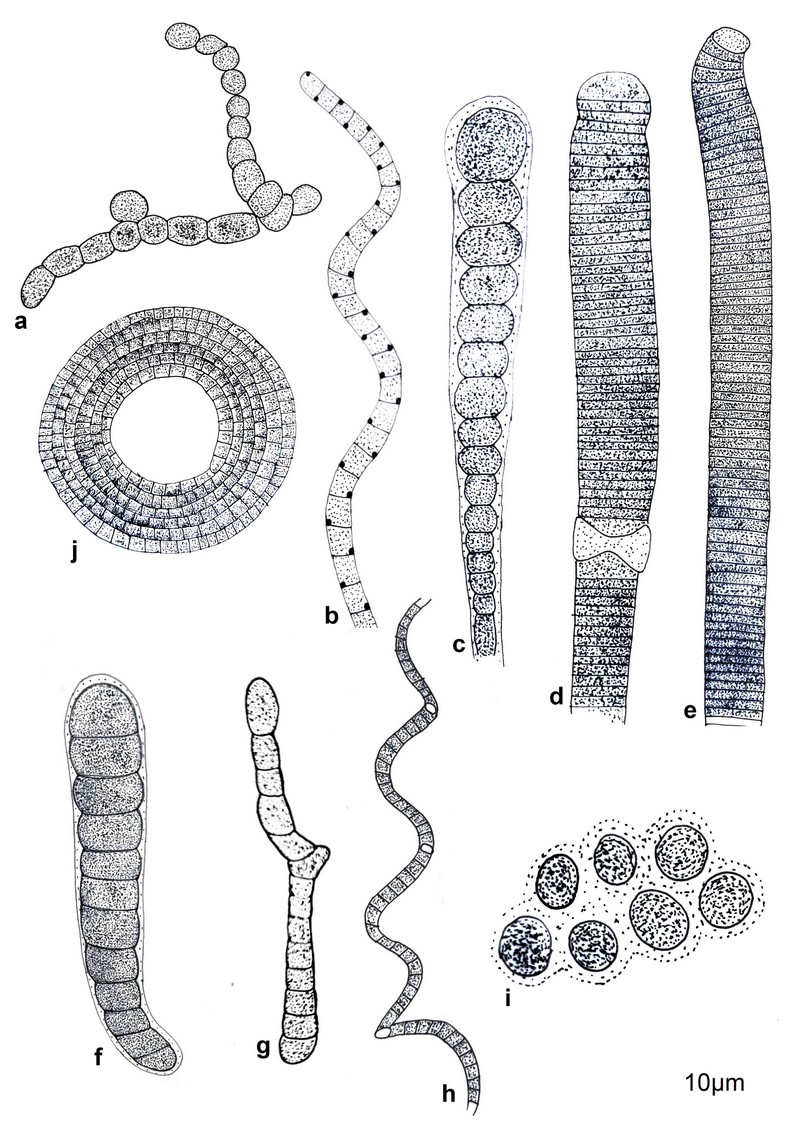
Figure 10. Line drawings of a. Mastigocladus laminosus, b. Leptolyngbya thermobia, c. Microchaete tenera, d. Oscillatoria princeps, e. Oscillatoria curviceps, f. Microchaete calothrichoides, g. Arthronema africanum, h. Arthrospira jenneri, i. Chroococcus membraninus, j. Planktolyngbya circumcreta.

Figure 11. Line drawings of a. Scytonema symposium, b. Anabaena laxa, c. Tolypothrix penicillata, d. Trichormus thermalis, e. Oscillatoria sancta, f. Planktothrix isothrix, g. Gloeocapsa arenaria, h. Aphanocapsa parietina, i. Spirulina meneghiniana, j. Fischerella thermalis.
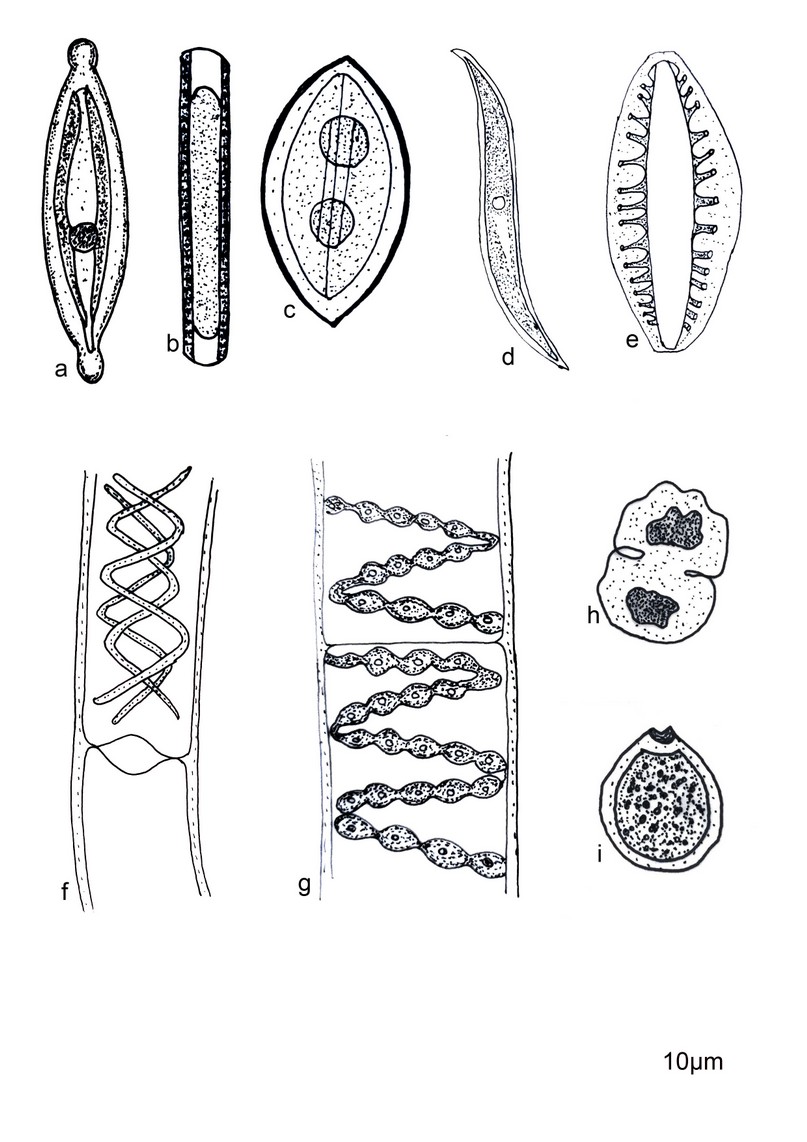
Figure 12. Line drawings of a. Navicula amphirhynchus, b. Brachysira exilis, c. Cocconeis placentula, d. Gyrosigma acuminatum, e. Rhopalodia operculata, f. Spirogyra reticulata, g. Spirogyra condensata, h. Heimansia pusilla, i. Trachelomonas volvocinopsis.

Figure 13. Comparison of the Temperature of high, pH, DO, HCO3-, K+, Ca2+, Cl-, Mg2+, SO42- , S2- , and NO3- values of the four geothermal springs of Odisha with the Kruskal-Wallis test in SPSS (P<0.001).
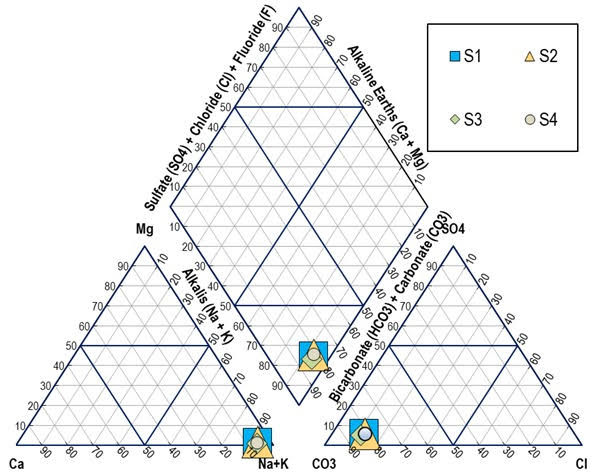
Figure 14. Classification of anion and cation values of four geothermal springs of Odisha by piper diagram (GW Chart Software (USGS) and Microsoft Excel 2016).

Figure 15. PCA analysis plot (Yellow circle: sampling stations, green triangle: taxa code, red arrow: water parameters [pH, T: temperature, Ca: Calcium (Ca2+), Cl: Chlorine (Cl-), DO: Dissolved Oxygen, HCO: Bicarbonate (HCO3-), K: Potassium (K+), Mg: Magnesium (Mg2+), NO: Nitrate (NO3-), S: Sulfide (S2-), SO: Sulfate (SO42-)].
47. Heimansia pusilla (L. Hilse) Coesel Cryptogamie, Algologie. 14:105-114. 1993 [Figures 7k and 12h]
Basionym- Cosmocladium pusillum L. Hilse 1866; Homotypic Synonym- Cosmocladium pusillum L. Hilse 1866; Heterotypic Synonyms- Euastrum pusillum Brébisson 1856; Cosmarium pusillum (Brébisson) W.Archer 1861
Cells are solitary, median constriction shallow, 16.42 µm long and 12.5 µm wide; semi- cells reniform with undulated or wavy margins.
Habitat: Outer channel of Tarabalo thermal spring, 34˚C
Voucher number: 82089
Date of collection: 26.09.2019
Phylum: Euglenozoa, Class: Euglenophyceae, Order: Euglenida, Family: Euglenidae, Genus: Trachelomonas
48. Trachelomonas volvocinopsis Svirenko Archiv für Hydrobiologie und Planktonkunde. 9:630-647. 1914 [Figures 7l and 12i]
Lorica smooth, spherical, 16.5-18.8 µm in diameter; apical pore 2.72 µm in diameter; presence of several discoid chloroplasts without pyrenoids in cells.
Habitat: Deulajhari main kund, 65˚C
Voucher number: 82081
Date of collection: 27.09.2019
Physico-chemical parameters and ecological aspects
In the present investigation, a total of 48 cyanobacteria and eukaryotic algae were identified from the four thermal springs of Odisha, India. During the study period, it was revealed that the pH of the water bodies was slightly basic (7.5-7.8) in all the sampling stations. Similarly, temperature was highest in Deulajhari (55-60°C) followed by Atri (45-60°C), Taptapani (45°C) and Tarabalo (35-45°C). The color variation of the habitat was transparent from green to dark green. The essential mineral elements like calcium, sodium and magnesium were varied in 4 thermal springs. The highest amount of calcium was recorded in Deulajhari (5.5 mg/L) whereas lowest was recorded in Taptapani (4.9 mg/L). Moderate amounts of calcium were found in both Atri (5.2 mg/L) and Tarabalo (5.1 mg/L). Sodium content in the hot water was found in the order: Deulajhari (97.72 mg/L)>Atri (96.75 mg/L)>Taptapani (92.25 mg/L)>Tarabalo (90.15 mg/L). Moderate amount of magnesium was found in all the sampling stations and ranges from 0.5-0.8 mg/L. Nitrate content in the hot spring water was high in Deulajhari (4.28 mg/L) followed by Atri (4.12 mg/L), Taptapani (3.86 mg/L) and Tarabalo (3.75 mg/L). Sulfate measured in Tarabalo was found to be high (48.81 mg/L) and low in Atri (46.85 mg/L). The order of sulfide content in four thermal springs was noted in the order: Deulajhari>Atri>Tarabalo>Taptapani (Table 1). Similar results were obtained in the Bakreswar (West Bengal) and Tattapani (Himachal Pradesh) thermal springs of India.2,22 Kruskal-Wallis test was used to determine the differences in physicochemical parameters of geothermal springs (P<0.001). DCA analysis was performed before the Kruskal-Wallis analysis. As a result of DCA analysis, physicochemical parameters that have important effects on the distribution of the species were determined (Temperature, pH, DO, HCO3-, K+, Ca2+, Cl-, Mg2+, SO42- , S2- , and NO3- ) (Figure 13). For statistically significant results, these parameters determined by DCA were used in Kruskal-Wallis analysis (Figure 13). As a result of the Kruskal-Wallis, the most important differences were observed in HCO3- values, while pH values were moderately basic in nature and did not show significant differences (Figure 13). The frequency of distribution of taxa according to pH, DO, HCO3-, K+, Ca2+, Cl-, Mg2+, SO42- , S2- , and NO3- values can be seen in

Figure 16. In addition, the piper diagram was used for convenience in the classification of four geothermal springs of Odisha, therefore anions and cations of the thermal water were compared. According to the Piper diagram, four sampling sites S1, S2, S3, and S4 were classified as a Na+-K+-HCO3- type (Figure 14).

Table 1. Physicochemical parameters of four sampling stations (EC-electrical conductivity, Cl--chlorine, DO-dissolved oxygen, PO43--phosphate, NH4+ -ammonium, HCO3- - bicarbonate, Na+ -sodium, K+-potassium, Ca2+-calcium, Mg2+-magnesium, SO42--sulfate, S2--sulfide, NO3--nitrate)
The diversity and abundance of cyanobacteria and other eukaryotic algae among 4 thermal springs are detailed in Table 2. Among 48 taxa, 39 taxa belong to cyanobacteria, and others belong to eukaryotic algae. Eukaryotic algae are diversified with 5 diatom species, 2 charophytes, 1 each of desmid and euglenophyte. The study revealed that cyanobacterium Jaaginema geminatum was dominant over the other species and commonly found in Taptapani, Tarabalo and Deulajhari hot springs. Similarly, Gloeocapsa Arenaria was found in both Taptapani and Tarabalo geothermal springs. It should be added that these taxa are widely distributed species with a wide range of tolerance to environmental variables. Other recorded species were restricted to single geothermal springs only, and that species account for 95% of all species. A total number of 14 species each from Taptapani, Tarabalo and Deulajhari Thermal springs were recorded, whereas only 9 species were reported from Atri. Previously Bhakta et al. have reported 50 species of cyanobacteria and other algal taxa from the same sampling sites12. But their study revealed the presence of 5 cyanobacteria viz., Aphanothece bullosa, Pseudanabaena catenata, Oscillatoria princeps, Mastigocladus laminosus, Planktolyngbya circumcreta and a single diatom species Rhopalodia operculata, which is similar to our study. Other 42 species are newly recorded in the sampling stations, which supports the environmental and anthropogenic alterations. Among them, Mastigocladus laminosus was dominant in the geothermal springs of Asian countries, including India and the United States.12 The fluctuations of temperature and nutrient load promote the diversification of cyanobacteria and other eukaryotic algae.
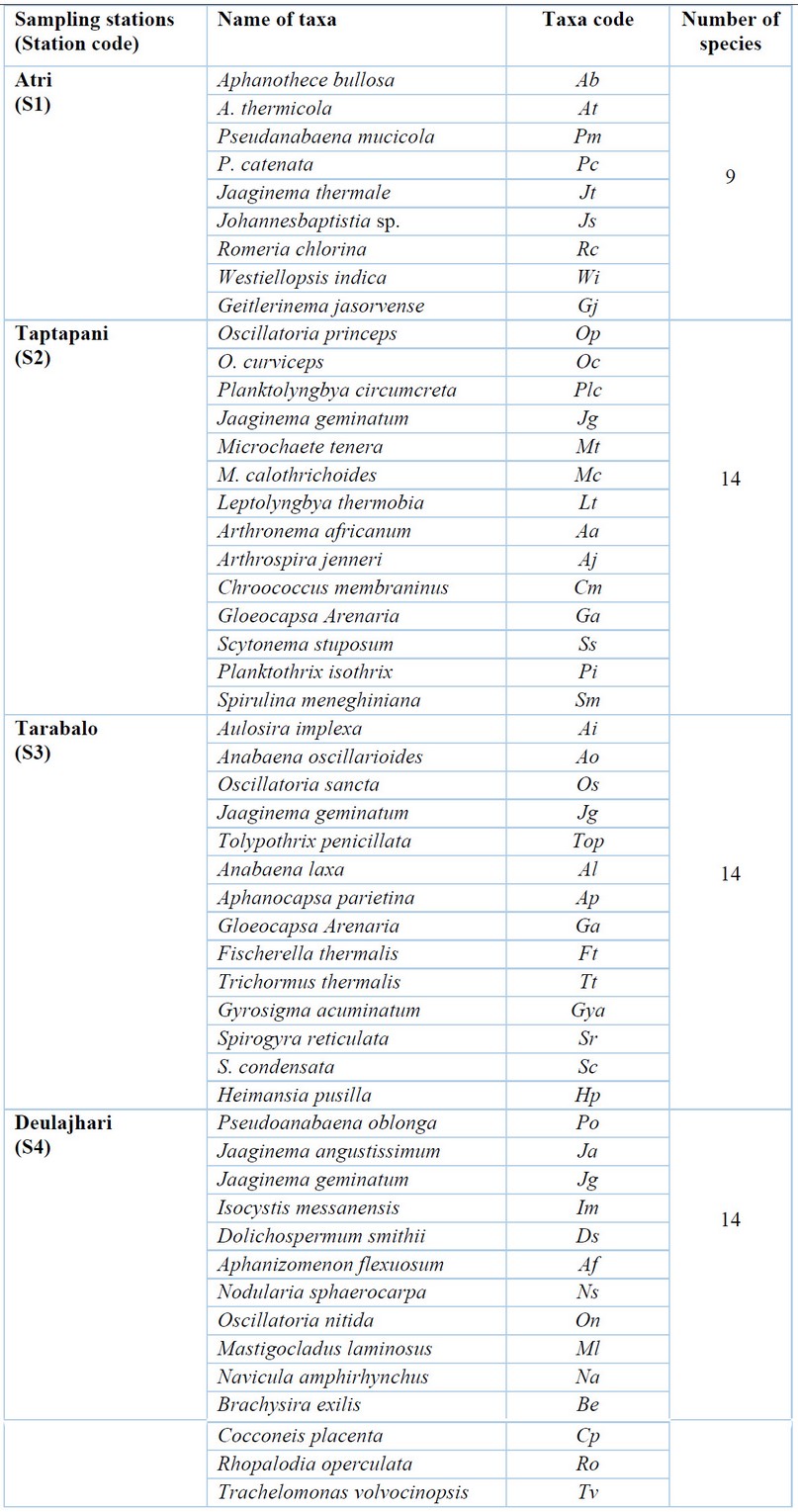
Table 2. Total number of species recorded in different sampling stations.
Temperature dependent variations in species composition suggested the dominance of mesothermophilic (≤ 45°C) and euthermophilic (45-65°C) taxa.2 In this study, Atri and Deulajhari are categorized as euthermophilous habitat whereas Taptapani and Tarabalo are categorized under mesothermophilous habitat. Among the cyanobacteria, Jaaginema geminatum was recorded from both euthermophilous and mesothermophilous communities. Hence, this species can be considered as true thermal species. Similarly, 4 diatom species, Navicula amphirhynchus, Brachysira exilis, Cocconeis placentula and Rhopalodia operculata were also investigated as true thermal species and recorded at 55-60°C from Deulajhari (Table 2). Trachelomonas volvocinopsis, the only green chlorophyte recorded as a true thermal species from the same locality. The extreme environment in present day thermal springs suggested an evolutionary line from Pre-Cambrian to modern age due to origin and existence of cyanobacteria and green algae. A sharp decline in the water temperature (45-60°C) resulted in the formation of Aphanothece, Pseudanabaena, Jaaginema, Johannesbaptistia, Romeria, Westiellopsis and Geitlerinema communities at Atri geothermal spring (Table 2). The Taptapani thermal spring (45°C) was loaded with the species of Jaaginema, Oscillatoria, Planktolyngbya, Microchaete, Leptolyngbya, Arthronema, Arthrospira, Chroococcus, Scytonema, Gloeocapsa, Planktothrix and Spirulina. The species considered as non- thermophilic (below 45°C), recorded from Tarabalo hot springs (35-45°C) showed the composition of Jaaginema, Aulosira, Anabaena, Tolypothrix, Aphanocapsa, Gloeocapsa, Fischerella, Trichormus, Oscillatoria, Gyrosigma, Spirogyra and Heimansia. Two species of Spirogyra, S. reticulata and S. condensata and Heimansiapusilla were recorded from Tarabalo (35-45°C) and stated as new from the site. Trachelomonas volvocinopsis, a thermophilic free-living euglenoid, was also recorded for the first time from Deulajhari main kund at 65°C. Diversification of species composition resulted in uniqueness among all hot springs of Odisha (Figure 15). DCA and PCA analyses were performed using the CANOCO software to demonstrate this uniqueness and correlation among all the spas of Odisha statistically. In the correlation analysis performed under CANOCO software, DCA analysis was first performed and the gradient lengths were evaluated (Axis 1: 0.00; Axis 2: 6.65). Physicochemical parameters were included in the forward selection step and the significance of their effects was supported by a Monte Carlo permutation test (499 permutations, F ratio < 0.1, P value = 1). Eleven physicochemical parameters (pH, Temperature, Ca2+, Cl-, DO, HCO3-, K+, Mg2+, NO3-, S2-, SO42-) determined by forward selection were included in the PCA analysis. These determined physicochemical parameters, sampling stations, and all identified species were included in the PCA analysis as explanatory variables for a statistical correlation. As a result of the PCA, the total variation was 36.2500, the first axis explained 36.84% of the variance (Figure 15). According to the PCA analysis, the sampling stations differ from each other in terms of their physicochemical parameters and species. According to the PCA analysis, the most effective parameters in the distribution of the species are the S2->K+>Ca2+>NO3- values, respectively, although there are very small differences between them. The species determined at sampling station S4 show a positive correlation with these most effective parameters S2-, NO3-, and Ca2+, while they show a negative correlation with K+. Species at sampling station S2 show an equally positive correlation with K+ and Mg2+. The species in the S3 sampling station have a high positive correlation with the SO42- value, as well as a positive correlation with the HCO3- value. Species at sampling station S3 and Jaaginema geminatum have a distribution independent of the measured physicochemical parameters. In this study, pH is not an effective parameter in the distribution of species. The occurrence of J. geminatum in all three stations and the absence of determining parameters in its distribution is an indicator of the wide ecological valence of this species. It has been reported that J. geminatum is found in many thermal waters in Bulgaria by Stoyneva-Gärtner et al.40 Also, J. geminatum was determined in the Dikili (İzmir Turkey) thermal spring by Öztürk Ulcay et al.41 The distribution not only in thermal waters but also in many different ecosystems can be seen as evidence of the wide ecological valence of this species.39 Although Pseudanabaena catenata is quite different in terms of physicochemical parameters, it has also been detected in different thermal waters with close temperature values.42-43 Although the Romeria chlorina showed a positive correlation with the temperature and PO43- values according to the RDA analysis in the study conducted by Öztürk,44 this study was determined from the S1 sampling station and did not show a distribution related to the physicochemical parameters. Oscillatoria princeps, which is a common species in fresh waters, is also frequently observed in thermal springs,44-48 Similarly, in this study, O. princeps was detected from the S2 station at a temperature of 45°C. In this study, Fischerella thermalis, which was sampled from the S3 station at 60 °C, was similarly recorded in the temperature range of 44-60 ◦C in many studies.2,11,45 Although pH does not appear to be the effective parameter in PCA analysis, F. thermalis, which was sampled from near-neutral pH, was similarly sampled from neutral pH by Roy et al.,11 and it was reported from higher pH ranges by other researchers.2,45
CONCLUSION
Thermal springs represent species of ecological and economic importance. Few studies revealed that thermophilic cyanobacteria like Mastigocladus, Synechococcus and Spirulina could produce important bioactives of biotechnological importance. The potential compound for degrading plastics is poly-β- hydroxybutyrate, present in abundance in thermophilic cyanobacteria Synechococcus.17 The same study revealed that Mastigocladus laminosus could produce ferredoxin, iron and sulfur-containing proteins, mostly used in the electron transport system and oxidation of macromolecules in plants.17 Antifungal, antimicrobial, and antileishmanial drug sources studies are also carried out on Aphanothece bullosa, one of the species we identified in this study.49-50 Present study highlighted the new record of Jaaginema geminatum from both low and high temperature regions. The tolerance of temperature can make this species potential for ecological as well as economic benefits. Romeria chlorina, Isocystis messanensis, Trichormus thermalis, Geitlerinema jasorvense and Westiellopsis indica were found as new from the study area in respect to the studies done by other author groups. On the other hand, Isocystis messanensis was found to be new to Indian flora. Among the hydrological parameters, bicarbonate made major differences in species distribution suggesting photosynthetic activity. Hence, the present study concludes that the taxonomic implications of cyanobacteria and other eukaryotic algae from thermal springs can draw a biotechnological outline for future prospects. Geothermal springs should be recognized and protected as important ecological habitats. It is also important to protect these areas of potentially valuable and interesting thermal species.
Acknowledgments
The authors are thankful to the Director, Botanical Survey of India, for providing lab facilities and to the Ministry of Environment, Forest and Climate Change, Govt. of India, for financial assistance. The authors extend their gratitude to the principal and all the staff of the Botany department, Bangabasi Evening College, for their encouragement and support.
Author's contribution: GGS has written the manuscript, structured and reviewed the final draft, PB has made the identification, description and plate preparation, SO has done the statistical analysis, RKG and MES has reviewed the manuscript.
Conflict of interest: Authors declare that there is no conflict of interest.
REFERENCES
1. Sahu, A.; Kaur, P.; Bhattacharjya, S.; Amat, D.; Sahu, N.; Bharti, N.; Tiwari, A.; Singh, A.B. Indian hot water springs: potential source of thermophilic microbes. Harit Dhara 2020, 3(2), 15-18.
2. Debnath, M.; Mandal, N.C.; Ray, S. The study of cyanobacterial flora from geothermal springs of Bakreswar, West Bengal, India. Algae 2009, 24(4), 185-193. https://doi.org/10.4490/algae.2009.24.4.185
3. Emoto, Y.; Yoneda, Y. Bacteria and algae of hot springs in Toyama Prefecture. Japanese J. Plant Syst. 1942, XI, 7–26.
4. Prasad, B.N.; Srivastava, P.N. Thermal algae from Himalayan hot springs. Proc. Natl. Acad. Sci., India 1965, 31, 45-53.
5. Vasishta, P.C. Thermal cyanophyceae of India- I. Phykos 1968, 7, 198–341.
6. Castenholz, R.W. Thermophilic blue-green algae and the thermal environment. Bacteriol. Rev. 1969, 33(4), 476-504.
7. Prasad, B.N.; Jaitly, Y.C.; Mishra, P.K. Some diatoms from the hotspring of Ladakh. Geophytology 1984, 14, 156-160.
8. Jha, M.; Kumar, H.D. Cyanobactrial flora of two hot springs of Rajgir, Bihar. Proc. First Conv. Green Veg. Leaf Protein Res. 1986, 33–40.
9. Thomas, J.; Gonzalves, E. Thermal algae of Western India. V. Algae of the hot spring at Tuwa. Hydrobiologia 1995, 26, 41-54.
10. Hindák, F. On Chlorogloeopsis fritschii (Cyanophyta/ Cyanobacteria) from thermal springs in Slovakia and from a saline lake in Tunisia. Algol. Stud. 2008, 126, 47-64.
11. Roy, S.; Debnath, M.; Ray, S. Cyanobacterial flora of the geothermal springs at Panifala, West Bengal, India. Phykos 2014, 44(1), 1-8.
12. Bhakta, S.; Das, S.K.; Adhikary, S.P. Algal diversity in hot springs of Odisha. Nelumbo 2016, 58, 157-173. https://doi.org/10.20324/nelumbo/v58/2016/105914
13. Das, S.K. Phycological explorations of thermal springs of India: floristic updation from Arunachal Pradesh (Eastern Himalayas). In: Nagaraj, S. (Eds.), Algae (Biodiversity, Biology and Biotechnology). Centre for Advanced Studies in Botany, University of Madras, Guindy Campus, Chennai, 2019, pp. 41-63.
14. Jana, B.B. The plankton ecology of some thermal springs in West Bengal, India. Hydrobiologia 1978, 61, 135-143.
15. Sinha, B.D.; Chaubey, L.M. Cyanobacterial flora of Bhimbandh hotspring. Proc. First Conv. Green Veg. Leaf Protein Res. 1986, 1–10.
16. Sompong, U.; Hawkins, P.R.; Besley, C.; Peer- Apornpisal, Y. The distribution of cyanobacteria across physical and chemical gradients in hot springs in northern Thailand. FEMS Microbiol. Ecol. 2005, 52(3), 365–376. https://doi.org/10.1016/j.femsec.2004.12.007
17. Lukavský, J.; Furnadzhieva, S.; Pilarski, P. Cyanobacteria of the thermal spring at Pancharevo, Sofia, Bulgaria. Acta Bot. Croat. 2011, 70(2), 191-208. https://doi.org/10.2478/v10184-010-0015-4
18. Javor, B.J. Cancer drugs from thermophilic cyanobacteria. Grant National Cancer Institute. http://www.researchcrossroads.org/index.php?view=article&id=50%3Agrant- - details&option=com_content&Itemid=37&grant_id=2626930. 1999, Access: 27.11.2009.
19. Pattanaik, H.; Rao, S.D. Thermal cyanophyceae from South Odisha. Curr. Sci. 1972, 41, 345.
20. Rao, S.D.; Pattanaik, H. Studies on some blue-green algae growing at high temperature. Phykos 1975, 14, 27-28.
21. Adhikary, S.P.; Sahu, J. Limnology of the thermal springs of Odisha. J. Bombay Nat. Hist. Soc. 1987, 84, 497-502.
22. Mongra, A.C. Distribution pattern of cyanobacteria in hot water springs of Tattapani, Himachal Pradesh, India. J. Acad. Ind. Res. 2012, 1(7), 363- 370.
23. Piper, A.M. A graphic procedure in geochemical interpretation of water analysis. Transactions American Geophysical Union 1944, 25, 914-928.
24. Winston, R.B.GW Chart version 1.30: US Geological Survey Software Release, 2020.
25. Ter Braak, CJF; Smilauer, P. Canoco Reference Manual and User's Guide: Software for Ordination. Microcomputer Power, Ithaca, NY, USA, 2012.
26. APHA. Standard methods for the examination of water and wastewater (19th ed.),Washington, D. C. 1998.
27. Desikachary, T.V. Cyanophyta. ICAR Monograph on algae. New Delhi, 1959, p. 68.
28. Gärtner, G. Syllabus der Boden-, Luft- und Flechtenal- gen. Stuttgart, Germany, 1995, p. 699.
29. Komárek, J.; Anagnostidis, K. Cyanoprokaryota I. Teil: Chroococcales. In: Herausgegeben von, H.E., G. Gärtner, H. Heynig, D. Mollenhauer (Eds.) Süßwasserflora von Mitteleuropa, Gaustav Fischer, 1998, p. 548.
30. Komárek, J.; Anagnostidis, K. Süsswasserflora von Mitteleuropa. Cyanoprokaryota: 2.Teil/2nd Part: Oscillatoriales 2005, 19, 1-759.
31. Satpati, G.G.; Das, M.; Pal, R. Morphotaxonomic account of freshwater blue-green and green algae of West Bengal, India. J. Bot. Soc. Bengal 2012, 66(1), 9-20.
32. Satpati, G.G.; Barman, N.; Pal, R. A study on green algal flora of Indian Sundarbans mangrove forest with special reference to morphotaxonomy. J. Algal Biomass Utln. 2013, 4(1), 26-41.
33. Satpati, G.G.; Bose, R.; Pal, R. Taxonomic investigation of euplanktonic diatom communities as indicator of copper in the bank of the Subarnarekha River, Jharkhand, India. J. Microbiol. Biotechnol. Food Sci. 2021, e2827, 1-8. https://doi.org/10.15414/jmbfs.2827
34. Barman, N.; Satpati, G.G.; Pal, R. A morphotaxonomic account of cyanobacterial diversity of Indian Sundarbans. J. Algal Biomass Utln. 2015, 6(3), 39- 46.
35. Satpati, G.G.; Pal, R. Microalgal diversity from three subdivisions of Paschim Medinipur district, West Bengal, India. J. Bot. Soc. Bengal 2011, 65(2), 151-163.
36. Satpati, G.G.; Pal, R. New and rare records of filamentous green algae from Indian Sundarbans Biosphere Reserve. J. Algal Biomass Utln. 2016, 7(2), 159- 175.
37. Satpati, G.G.; Pal, R. Taxonomic diversity and SEM study of euglenoids from brackish water ecosystems of Indian Sundarbans biosphere reserve. Phykos 2017, 47(1), 105-122.
38. Satpati, G.G.; Pal, R. SEM study of planktonic chlorophytes from the aquatic habitat of the Indian Sundarbans and their conservation status. J. Threat. Taxa 2019, 11(13), 14722-14744. https://doi.org/10.11609/jott.4422.11.13.14722-14744
39. Guiry, M.D.; Guiry, G.M. AlgaeBase, Worldwide electronic publication, National University of Ireland, Galway. http://www.algaebase.org; searched on 30 January, 2023.
40. Stoyneva-Gärtner, M.P.; Uzunov, B.A.; Gärtner, G. Checklist of Algae From Bulgarian Thermal Waters, Annual of Sofia University “St. Kliment Ohridski” Faculty of Biology Book 2 – Botany 102, 2018, 49-73.
41. Öztürk Ulcay, S.; Öztürk, M.; Kurt, O.; Taşkın, E.; Öztürk, M. Dikili İlçesi (İzmir) Kaplıcalarında Yayılış Gösteren Termal Cyanophyceae (Mavi-Yeşil alg) Türleri [Cyanophyceae (Blue-Green Algae) of Dikili/İzmir Thermal Spring]. Türk Sucul Yaşam Dergisi 2007, 5(8), 371-378.
42. Arif, I.A. Composition of blue-green algal mats and water chemistry of the Bani Malik hot spring (Gizan Province), Saudi Arabia. Kuwait J. Sci. Eng. 1997, 24, 109-122.
43. Öztürk Ulcay, S.; Kurt, O. Algae Flora of Germencik-Alangüllü (Aydın, Turkey) Thermal Water. Celal Bayar Univ. J. Sci. 2017, 13(3), 601-608. http://dx.doi.org/10.18466/cbayarfbe.339279
44. Öztürk, S. Cyanobacterial Diversity and Physicochemical Characteristics of Thermal Springs in The Kütahya Province of Turkey. Bangladesh J. Plant Taxon. 2021, 28(2), 413-428. https://doi.org/10.3329/bjpt.v28i2.57137
45. Roy, S.; Bhattacharya, S.; Debnath, M.; Ray, S. Diversity of cyanobacterial flora of Bakreswar geothermal spring, West Bengal, India-II. Algol. Stud. 2015, 147, 29-44.
46. Gupta, R.K. Mini review: Thermal algae of India with special reference to Jharkhand. Biospectra 2017, 12(2), 15-20.
47. Singh, V.K.; Verma, D.; Nayaka, S.; Toppo, K.; Lavania, S. Cyanobacterial flora from thermal springs of the Kullu District, Himachal Pradesh, India. J. Indian Bot. Soc. 2018, 97(3-4), 31-37.
48. Basu, P.; Satpati, G.G.; Öztürk, S.; Gupta, R.K. Taxonomic and ecological aspects of thermophilic cyanobacteria from some geothermal springs of Jharkhand and Bihar, India. Egyptian J. Bot. 2023, 63(1), 315-331. https://doi.org/10.21608/EJBO.2022.145568.2021.
49. Kumar, M.; Tripathi, M.K.; Srivastava, A.; Gour, J.K.; Singh, R.K.; Tilak, R.; Asthana, RK Cyanobacteria, Lyngbya aestuarii and Aphanothece bullosa as antifungal and antileishmanial drug resources. Asian Pac. J. Trop. Biomed. 2013, 3(6), 458-463. https://doi.org/10.1016/S2221-1691(13)60096-9.
50. Kumar, M.; Singh, P.; Tripathi, J.; Srivastava, A.; Tripathi, M.K.; Ravi, A.K.; Asthana, RK Identification and structure elucidation of antimicrobial compounds from Lyngbya aestuarii and Aphanothece bullosa. Cell. Mol. Biol. 2014, 60(5), 82-89. https://doi.org/10.14715/cmb/2014.60.5.14
Received: 25 June 2023/ Accepted: 26 August 2023 / Published:15 September 2023
Citation: Gopal Satpati G, Basu P, Öztürk S, Kumar Gupta R, El-Sheekh M. Taxonomic and ecological characteristics of algal assemblage in four geothermal springs of Odisha, India, including some new records. Revis Bionatura 2023;8 (3) 110 http://dx.doi.org/10.21931/RB/2023.08.03.110
